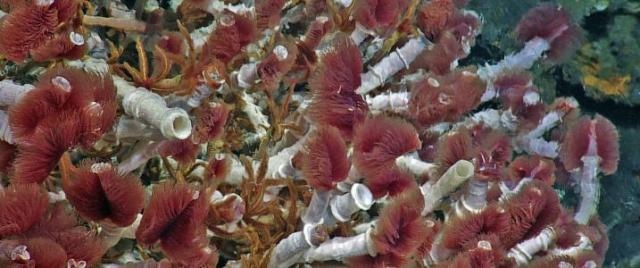Jun 1 2016
Hydrothermal vents and methane seeping on to the ocean floor was once believed to be biological and geologic oddities. However, they are now considered as a key factor in marine life, global climate, and ecosystems. On one side, researchers are working towards sustaining a healthy Earth, but on the other, habitats are being negatively impacted by numerous human activities, including bottom trawling, deep-sea mining, and energy harvesting. These facts were reported by researchers in a paper published in Frontiers in Marine Science.
 A lush community of vibrant red tube worms grows on a black smoker chimney in the ASHES hydrothermal field. The tube worms, which are hosted in white housings about the diameter of a person's small finger, are intergrown with brown palm worms. (Photo credit: Courtesy of University of Washington, NSF/Ocean Observatories Initiative/Canadian Scientific Submersible Facility)
A lush community of vibrant red tube worms grows on a black smoker chimney in the ASHES hydrothermal field. The tube worms, which are hosted in white housings about the diameter of a person's small finger, are intergrown with brown palm worms. (Photo credit: Courtesy of University of Washington, NSF/Ocean Observatories Initiative/Canadian Scientific Submersible Facility)
Nearly 40 years ago, Oregon State University (OSU) researchers discovered these extraordinary, isolated worlds on the ocean floor. These habitats revealed that there were sulfide chimneys, giant crabs and mussels, bizarre tube worms, and hot oozing gases. Researchers later learnt that these life forms were found to eat toxic sulfide and methane.
It was immediately apparent that these hydrothermal vents were incredibly cool. Since then we’ve learned that these vents and seeps are much more than just some weird fauna, unique biology and strange little ecosystems. Rather than being an anomaly, they are prevalent around the world, both in the deep ocean and shallower areas. They provide an estimated 13 percent of the energy entering the deep sea, make a wide range of marine life possible, and are major players in global climate.
Andrew Thurber, Assistant Professor, College of Earth, Ocean and Atmospheric Sciences, OSU
The vents act as fountains of marine life, providing gases and minerals such as methane, iron, hydrogen, and sulfide, which are restricting nutrients in plankton growth in wide regions of the ocean. A more crucial role of these vents is that the life forms consume 90% of the released methane and preventing it from polluting the atmosphere, where as a greenhouse gas it is 25 times more powerful and detrimental than carbon dioxide.
We had no idea at first how important this ecological process was to global climate. Through methane consumption, these life forms are literally saving the planet. There is more methane on the ocean floor than there are other forms of fossil fuels left in the oceans, and if it were all released it would be a doomsday climatic event.
Andrew Thurber, Assistant Professor, College of Earth, Ocean and Atmospheric Sciences, OSU
In analyzing the position of these marine geological structures and the life forms living around them, a collaborative team of researchers belonging to 14 international organizations and universities have listed out all their learning from the past 40 years including all the forces that may harm these ecosystems today. The J.M. Kaplan fund supported this task.
The rocks and habitat created by these vents and seeps, in addition to the the marine life, are likely to last for thousands of years. They discharge energy and heat, and develop biological hot spots of diversity. They host widespread mounds of crab and shrimp, and clam beds and mussel, produce some key fishing habitat, and fertilize the ocean as zooplankton biomass. All of this increases abundance. Although the fluid flows cover only a small portion of the seafloor, the effect on the ocean is universal.
Now studies are being performed on some of the microorganisms from these places to see if they can act as a biocatalytic agent for industrial scrubbing of carbon dioxide or help degrade oil spills.
According to the scientists, these systems have already been harmed by human exploitation, and others are being targeted. Mining for gold, copper, lead, zinc, and silver are also being looked into. Bottom trawling is another area of concern, as it causes physical disturbance that could hinder seeps, impact habitat, and harm other biologic linkages.
Oil, hydrate, or gas exploitation may also harm seeps. Logging and whaling are also potential issues as they might hinder with organic substances reaching to the ocean floor, which act as habitat or stepping stones for species dependent on chemosynthetic energy sources. Waste disposal of sewage, munitions, and debris will also impact seeps.
According to the report, the various ecosystem services that these vents and seeps offer are yet to be fully understood. To solve any of these issues would require global collaboration and understanding as several of these habitats are found beyond the territorial waters.
Contributors to this report included researchers from the Scripps Institution of Oceanography, Florida State University, the National Institute of Water and Atmospheric Research in New Zealand, University of the Azores, Temple University, Universidade de Aveiro, the U.S. Geological Survey, University of the West Indies, Dalhousie University, University of Victoria, Duke University, Ghent University and the University of Hawaii at Manoa.